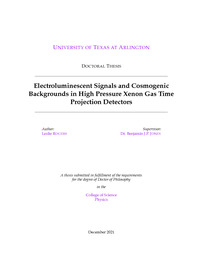
ATTENTION: The works hosted here are being migrated to a new repository that will consolidate resources, improve discoverability, and better show UTA's research impact on the global community. We will update authors as the migration progresses. Please see MavMatrix for more information.
Show simple item record
| dc.contributor.advisor | Jones, Benjamin JP | |
| dc.contributor.advisor | Nygren, David | |
| dc.creator | Rogers, Leslie | |
| dc.date.accessioned | 2023-06-28T15:29:01Z | |
| dc.date.available | 2023-06-28T15:29:01Z | |
| dc.date.created | 2021-12 | |
| dc.date.issued | 2022-01-10 | |
| dc.date.submitted | December 2021 | |
| dc.identifier.uri | http://hdl.handle.net/10106/31383 | |
| dc.description.abstract | The NEXT collaboration is developing a sequence of high pressure xenon gas time projection chambers with the aim of creating a ton-scale, very low background neutrinoless double beta decay search. Finding evidence of neutrinoless double beta decay would give insight into the origins of the matter-antimatter asymmetry in the universe, the smallness of neutrino mass, and the symmetry structure of the Standard Model. My research involves addressing critical challenges on the path to realization of high pressure xenon gas detectors for ton-scale, very low background neutrinoless double beta decay searches. While most aspects of this technology are easily scalable, some detector elements require R&D in order to be realized on a large scale. These challenges include creating electroluminescent regions and high voltage systems capable of holding high and well controlled electric fields as well as reducing and understanding backgrounds.136Xe is used as the target medium for many experiments searching for 0νββdecay. Despite underground operation, cosmic muons that reach the laboratory can produce spallation neutrons causing activation of detector materials. A potential background that is difficult to veto comes in the form of137Xe created by the capture of neutrons on136Xe. These spallation neutrons are directly proportional to the muon rate and therefore the cosmogenic background rate can be predicted once the muon flux is known. This work developed an analysis that was able to predict and measure the muon rate through NEXT-White.This work also proposes and explores the concept of adding a small percentage of3He to xenon as a means to capture thermal neutrons and reduce the number of activations in the detector volume. When using this technique we find the contamination from137Xe activation can be reduced to negligible levels in tonne and multi-tonne scale high pressure gas xenon neutrinoless double beta decay experiments running at any depth in an underground laboratory.With the cosmogenic backgrounds well understood the realization of very low background, tonne-scale comes closer to reality. | |
| dc.format.mimetype | application/pdf | |
| dc.language.iso | en_US | |
| dc.subject | Neutrinoless double beta decay | |
| dc.subject | Helium 3 | |
| dc.subject | Insulators | |
| dc.subject | High voltage | |
| dc.title | Electroluminescent Signals and CosmogenicBackgrounds in High Pressure Xenon Gas TimeProjection Detectors | |
| dc.type | Thesis | |
| dc.date.updated | 2023-06-28T15:29:02Z | |
| thesis.degree.department | Physics | |
| thesis.degree.grantor | The University of Texas at Arlington | |
| thesis.degree.level | Doctoral | |
| thesis.degree.name | Doctor of Philosophy in Physics and Applied Physics | |
| dc.type.material | text | |
| dc.creator.orcid | 0000-0001-6505-1157 | |
Files in this item
- Name:
- ROGERS-DISSERTATION-2021.pdf
- Size:
- 43.32Mb
- Format:
- PDF
This item appears in the following Collection(s)
Show simple item record


